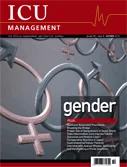
Editorial
Gender
Even in a world full of innovation, developments and advanced intensive care medicine, there are areas and issues within the realm of critical care that are overlooked, at least on a comprehensive scale. As more studies and research projects are completed, and new experiences and knowledge are shared across the speciality, the quality and standard of intensive care medicine and processes are improving in...
Exhibitors @ RSNA 2010
European STEMI Guidelines Emphasise Care Coordination
The European Society of Cardiology (ESC) guidelines for the management of patients with acute ST elevation MI (STEMI) anticipate spurring efforts to improve the speed and efficiency of STEMI care in Europe. The new recommendations, which were announced at the European Society of Cardiology 2012 Congress on 26 August, suggest a new standard for time from medical contact to ECG of 10 minutes. Two...
Research News
Elevated Glucose Levels Predict Mortality in Pneumonia Patients
Non-diabetic patients who have elevated serum glucose levels when they are admitted to the hospital presenting community-acquired pneumonia (CAP) have an increased risk of dying within 90 days compared with normoglycemic patients with the same illness, suggest studies presented at the European Respiratory Society (ERS) 2012 Annual Congress in Vienna, Austria, on 2 September. High serum glucose l...
Cover Story: Gender
Sex in the ICU: Eliminating Gender-Based Disparities in Care
The time has come to apply a sex and gender lens to quality improvement in ICU care, considering not just biological differences but also potential gender bias from decision makers, among other factors. The authors of this article explore the current context of quality standards and indicators, and assess how access, quality and outcomes across genders can be optimised. Introduction Great strides h...
End of Emancipation: Unravelling the Effect of Gender on ICU Mortality
AuthorsIrit Nachtigall, MD Sascha Tafelski, MD Maxim Kartachov, MD Claudia Spies, MD Department of Anaesthesiology and Intensive Care Charité University Hospital Campus Charité Mitte and Campus Virchow-Klinikum Berlin, Germany Introduction Debates have long existed on whether gender might either impact intensive care unit (ICU) outcome in general or only in distinct patient populations. Studies have...
Nutrition Management
Optimal Nutrition in Intensive Care: Does Gender Matter?
Several gender differences relate to optimal nutrition in intensive care. We describe these differences and their hypothetical implications for the patient. Introduction Nutrition therapy is an integral and important part of therapy in the intensive care unit (ICU). Malnutrition leads to more complications, more infections, longer hospital stays and even death (Lochs 2006, Norman 2008). Maintenanc...
Peri Operative Nutrition in Upper Gastrointestinal Cancer Patients
Malnutrition is frequently observed in upper gastrointestinal cancer surgical patients; it is an independent predictor of postoperative morbidity and mortality and leads to both increased length of hospital stay and hospital costs. Consequently, every effort should be made to apply nutritional support, including both standard enteral nutrition (EN) and immunonutrition, as a complementary therapeutic limb...
Matrix Features
Proper Use of Vasopressors in Septic Shock
Introduction Several factors contribute to organ dysfunction in septic shock patients, and once the inflammatory response has been activated, many organ systems can be adversely affected. A marked fall in systemic vascular resistance results from arterial and venous dilatation. This is accompanied by leakage of plasma into the extravascular space, leading to relative hypovolemia. The microcirculation is...
Ventilator Associated Pneumonia: Breaking the Bridge
In this article we look at strategies for preventing lower airway colonisation, focusing on the factor that is widely-believed to be the main culprit forventilator associated pneumonia (VAP) development: the endotracheal tube (ETT). VAP and its Pathogenesis Ventilator associated pneumonia, defined as occurrence of pneumonia at least 48–72 hours after commencement of mechanical ventilation, is kn...
On-Demand Chest X-Ray Ordering in the ICU: Prescribing Efficacy
Eliminating Redundant Chest RadiologyIt is common for patients in the ICU, particularly those who are mechanically ventilated, to have daily routine chest radiographs in an attempt to find relevant abnormalities that would otherwise remain undetected. A large study by Graat and colleagues evaluated the clinical value of 2,457 routine CXRs in a combined surgical and medical ICU and found that only 5.8% of ro...
Management
Developing and Harmonising a Prime Speciality: Intensive Care Medicine
An interview with Andrew Rhodes President of the European Society of Intensive Care Medicine (ESICM), Andrew Rhodes, has committed much of his time to progressing intensive care medicine as well as introducing and strengthening strategies for raising and harmonising standards in medical practice. In this interview with Managing Editor Marianna Keen, he shares some of his most recent achievements, and ot...
Matrix
Does Intermediate Care Improve Patient Outcomes and Reduce Costs?
In an era of rapidly progressing intensive care medicine, along with rising demand and growing concern on the bottom line, hospital managers are increasingly introducing intermediate care facilities in a move to solve the problem of overcrowded ICUs in an efficient manner; but controversy exists on whether these units really provide all the answers. Introduction Intensive care medicine has develop...
Country Focus: Portugal
The Portuguese Healthcare System: Universal and Comprehensive
Located in the south-west of Europe, with a mainland area of 91,900 km², along with the archipelagos of Açores and Madeira, Portugal is a developed country with a lot to offer, including a health system with many strengths. Amid the economic crisis and an ageing population, however, the country is facing problems in this sector. In response to this, the Ministry of Health has proposed a sustainability...
Intensive Care Medicine in Portugal: Responding to Changes
The economic crisis in Portugal has forced the Government to impose major budget cuts in the National Health Service, and although the level of care for critically ill patients until now has remained adequate, intensive care medicine in the country is feeling limitations. Overview Since the first intensive care unit (ICU) to be established in Portugal was opened in Coimbra in the sixties, intensive care m...

